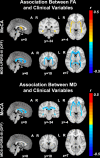A worldwide study of white matter microstructural alterations in people living with Parkinson's disease
- PMID: 39128907
- PMCID: PMC11317500
- DOI: 10.1038/s41531-024-00758-3
A worldwide study of white matter microstructural alterations in people living with Parkinson's disease
Abstract
The progression of Parkinson's disease (PD) is associated with microstructural alterations in neural pathways, contributing to both motor and cognitive decline. However, conflicting findings have emerged due to the use of heterogeneous methods in small studies. Here we performed a large diffusion MRI study in PD, integrating data from 17 cohorts worldwide, to identify stage-specific profiles of white matter differences. Diffusion-weighted MRI data from 1654 participants diagnosed with PD (age: 20-89 years; 33% female) and 885 controls (age: 19-84 years; 47% female) were analyzed using the ENIGMA-DTI protocol to evaluate white matter microstructure. Skeletonized maps of fractional anisotropy (FA) and mean diffusivity (MD) were compared across Hoehn and Yahr (HY) disease groups and controls to reveal the profile of white matter alterations at different stages. We found an enhanced, more widespread pattern of microstructural alterations with each stage of PD, with eventually lower FA and higher MD in almost all regions of interest: Cohen's d effect sizes reached d = -1.01 for FA differences in the fornix at PD HY Stage 4/5. The early PD signature in HY stage 1 included higher FA and lower MD across the entire white matter skeleton, in a direction opposite to that typical of other neurodegenerative diseases. FA and MD were associated with motor and non-motor clinical dysfunction. While overridden by degenerative changes in the later stages of PD, early PD is associated with paradoxically higher FA and lower MD in PD, consistent with early compensatory changes associated with the disorder.
© 2024. The Author(s).
Conflict of interest statement
The authors declare no competing interests.
Figures




References
Grants and funding
LinkOut - more resources
Full Text Sources
Miscellaneous

